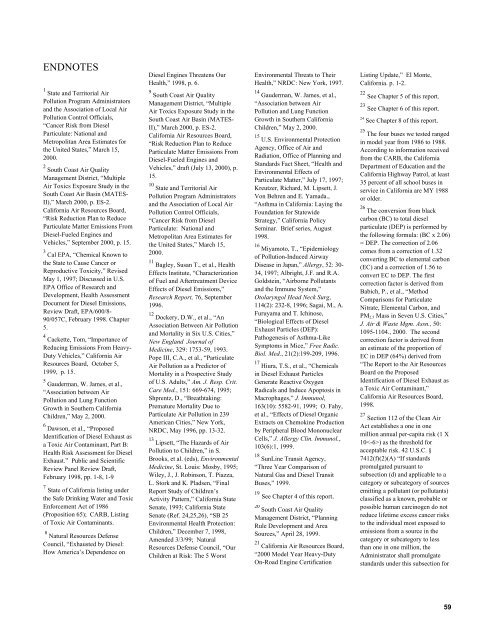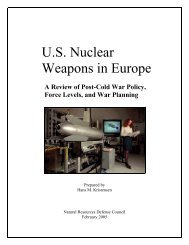NRDC: No Breathing in the Aisles: Diesel Exhaust Inside School ...
NRDC: No Breathing in the Aisles: Diesel Exhaust Inside School ...
NRDC: No Breathing in the Aisles: Diesel Exhaust Inside School ...
Create successful ePaper yourself
Turn your PDF publications into a flip-book with our unique Google optimized e-Paper software.
ENDNOTES<br />
1<br />
State and Territorial Air<br />
Pollution Program Adm<strong>in</strong>istrators<br />
and <strong>the</strong> Association of Local Air<br />
Pollution Control Officials,<br />
“Cancer Risk from <strong>Diesel</strong><br />
Particulate: National and<br />
Metropolitan Area Estimates for<br />
<strong>the</strong> United States,” March 15,<br />
2000.<br />
2<br />
South Coast Air Quality<br />
Management District, “Multiple<br />
Air Toxics Exposure Study <strong>in</strong> <strong>the</strong><br />
South Coast Air Bas<strong>in</strong> (MATES-<br />
II),” March 2000, p. ES-2.<br />
California Air Resources Board,<br />
“Risk Reduction Plan to Reduce<br />
Particulate Matter Emissions From<br />
<strong>Diesel</strong>-Fueled Eng<strong>in</strong>es and<br />
Vehicles,” September 2000, p. 15.<br />
3<br />
Cal EPA, “Chemical Known to<br />
<strong>the</strong> State to Cause Cancer or<br />
Reproductive Toxicity,” Revised<br />
May 1, 1997; Discussed <strong>in</strong> U.S.<br />
EPA Office of Research and<br />
Development, Health Assessment<br />
Document for <strong>Diesel</strong> Emissions,<br />
Review Draft, EPA/600/8-<br />
90/057C, February 1998. Chapter<br />
5.<br />
4<br />
Cackette, Tom, “Importance of<br />
Reduc<strong>in</strong>g Emissions From Heavy-<br />
Duty Vehicles,” California Air<br />
Resources Board, October 5,<br />
1999, p. 15.<br />
5<br />
Gauderman, W. James, et al.,<br />
“Association between Air<br />
Pollution and Lung Function<br />
Growth <strong>in</strong> Sou<strong>the</strong>rn California<br />
Children,” May 2, 2000.<br />
6<br />
Dawson, et al., “Proposed<br />
Identification of <strong>Diesel</strong> <strong>Exhaust</strong> as<br />
a Toxic Air Contam<strong>in</strong>ant, Part B:<br />
Health Risk Assessment for <strong>Diesel</strong><br />
<strong>Exhaust</strong>.” Public and Scientific<br />
Review Panel Review Draft,<br />
February 1998, pp. 1-8, 1-9<br />
7<br />
State of California list<strong>in</strong>g under<br />
<strong>the</strong> Safe Dr<strong>in</strong>k<strong>in</strong>g Water and Toxic<br />
Enforcement Act of 1986<br />
(Proposition 65); CARB, List<strong>in</strong>g<br />
of Toxic Air Contam<strong>in</strong>ants.<br />
8 Natural Resources Defense<br />
Council, “<strong>Exhaust</strong>ed by <strong>Diesel</strong>:<br />
How America’s Dependence on<br />
<strong>Diesel</strong> Eng<strong>in</strong>es Threatens Our<br />
Health,” 1998, p. 6.<br />
9<br />
South Coast Air Quality<br />
Management District, “Multiple<br />
Air Toxics Exposure Study <strong>in</strong> <strong>the</strong><br />
South Coast Air Bas<strong>in</strong> (MATES-<br />
II),” March 2000, p. ES-2.<br />
California Air Resources Board,<br />
“Risk Reduction Plan to Reduce<br />
Particulate Matter Emissions From<br />
<strong>Diesel</strong>-Fueled Eng<strong>in</strong>es and<br />
Vehicles,” draft (July 13, 2000), p.<br />
15.<br />
10<br />
State and Territorial Air<br />
Pollution Program Adm<strong>in</strong>istrators<br />
and <strong>the</strong> Association of Local Air<br />
Pollution Control Officials,<br />
“Cancer Risk from <strong>Diesel</strong><br />
Particulate: National and<br />
Metropolitan Area Estimates for<br />
<strong>the</strong> United States,” March 15,<br />
2000.<br />
11<br />
Bagley, Susan T., et al., Health<br />
Effects Institute, “Characterization<br />
of Fuel and Aftertreatment Device<br />
Effects of <strong>Diesel</strong> Emissions,”<br />
Research Report, 76, September<br />
1996.<br />
12<br />
Dockery, D.W., et al., “An<br />
Association Between Air Pollution<br />
and Mortality <strong>in</strong> Six U.S. Cities,”<br />
New England Journal of<br />
Medic<strong>in</strong>e, 329: 1753-59, 1993.<br />
Pope III, C.A., et al., “Particulate<br />
Air Pollution as a Predictor of<br />
Mortality <strong>in</strong> a Prospective Study<br />
of U.S. Adults,” Am. J. Resp. Crit.<br />
Care Med., 151: 669-674, 1995;<br />
Shprentz, D., “Breathtak<strong>in</strong>g:<br />
Premature Mortality Due to<br />
Particulate Air Pollution <strong>in</strong> 239<br />
American Cities,” New York,<br />
<strong>NRDC</strong>, May 1996, pp. 13-32.<br />
13<br />
Lipsett, “The Hazards of Air<br />
Pollution to Children,” <strong>in</strong> S.<br />
Brooks, et al. (eds), Environmental<br />
Medic<strong>in</strong>e, St. Louis: Mosby, 1995;<br />
Wiley, J., J. Rob<strong>in</strong>son, T. Piazza,<br />
L. Stork and K. Pladsen, “F<strong>in</strong>al<br />
Report Study of Children’s<br />
Activity Pattern,” California State<br />
Senate, 1993; California State<br />
Senate (Ref. 24,25,26), “SB 25<br />
Environmental Health Protection:<br />
Children,” December 7, 1998,<br />
Amended 3/3/99; Natural<br />
Resources Defense Council, “Our<br />
Children at Risk: The 5 Worst<br />
Environmental Threats to Their<br />
Health,” <strong>NRDC</strong>: New York, 1997.<br />
14<br />
Gauderman, W. James, et al.,<br />
“Association between Air<br />
Pollution and Lung Function<br />
Growth <strong>in</strong> Sou<strong>the</strong>rn California<br />
Children,” May 2, 2000.<br />
15<br />
U.S. Environmental Protection<br />
Agency, Office of Air and<br />
Radiation, Office of Plann<strong>in</strong>g and<br />
Standards Fact Sheet, “Health and<br />
Environmental Effects of<br />
Particulate Matter,” July 17, 1997;<br />
Kreutzer, Richard, M. Lipsett, J.<br />
Von Behren and E. Yamada.,<br />
“Asthma <strong>in</strong> California: Lay<strong>in</strong>g <strong>the</strong><br />
Foundation for Statewide<br />
Strategy,” California Policy<br />
Sem<strong>in</strong>ar. Brief series, August<br />
1998.<br />
16<br />
Miyamoto, T., “Epidemiology<br />
of Pollution-Induced Airway<br />
Disease <strong>in</strong> Japan,” Allergy, 52: 30-<br />
34, 1997; Albright, J.F. and R.A.<br />
Goldste<strong>in</strong>, “Airborne Pollutants<br />
and <strong>the</strong> Immune System,”<br />
Otolaryngol Head Neck Surg,<br />
114(2): 232-8, 1996; Sagai, M., A.<br />
Furuyama and T. Ich<strong>in</strong>ose,<br />
“Biological Effects of <strong>Diesel</strong><br />
<strong>Exhaust</strong> Particles (DEP):<br />
Pathogenesis of Asthma-Like<br />
Symptoms <strong>in</strong> Mice,” Free Radic.<br />
Biol. Med., 21(2):199-209, 1996.<br />
17<br />
Hiura, T.S., et al., “Chemicals<br />
<strong>in</strong> <strong>Diesel</strong> <strong>Exhaust</strong> Particles<br />
Generate Reactive Oxygen<br />
Radicals and Induce Apoptosis <strong>in</strong><br />
Macrophages,” J. Immunol,<br />
163(10): 5582-91, 1999; O. Fahy,<br />
et al., “Effects of <strong>Diesel</strong> Organic<br />
Extracts on Chemok<strong>in</strong>e Production<br />
by Peripheral Blood Mononuclear<br />
Cells,” J. Allergy Cl<strong>in</strong>. Immunol.,<br />
103(6):1, 1999.<br />
18<br />
SunL<strong>in</strong>e Transit Agency,<br />
“Three Year Comparison of<br />
Natural Gas and <strong>Diesel</strong> Transit<br />
Buses,” 1999.<br />
19<br />
See Chapter 4 of this report.<br />
20<br />
South Coast Air Quality<br />
Management District, “Plann<strong>in</strong>g<br />
Rule Development and Area<br />
Sources,” April 28, 1999.<br />
21<br />
California Air Resources Board,<br />
“2000 Model Year Heavy-Duty<br />
On-Road Eng<strong>in</strong>e Certification<br />
List<strong>in</strong>g Update,” El Monte,<br />
California. p. 1-2.<br />
22<br />
See Chapter 5 of this report.<br />
23<br />
See Chapter 6 of this report.<br />
24<br />
See Chapter 8 of this report.<br />
25<br />
The four buses we tested ranged<br />
<strong>in</strong> model year from 1986 to 1988.<br />
Accord<strong>in</strong>g to <strong>in</strong>formation received<br />
from <strong>the</strong> CARB, <strong>the</strong> California<br />
Department of Education and <strong>the</strong><br />
California Highway Patrol, at least<br />
35 percent of all school buses <strong>in</strong><br />
service <strong>in</strong> California are MY 1988<br />
or older.<br />
26<br />
The conversion from black<br />
carbon (BC) to total diesel<br />
particulate (DEP) is performed by<br />
<strong>the</strong> follow<strong>in</strong>g formula: (BC x 2.06)<br />
= DEP. The correction of 2.06<br />
comes from a correction of 1.32<br />
convert<strong>in</strong>g BC to elemental carbon<br />
(EC) and a correction of 1.56 to<br />
convert EC to DEP. The first<br />
correction factor is derived from<br />
Babich, P., et al., “Method<br />
Comparisons for Particulate<br />
Nitrate, Elemental Carbon, and<br />
PM2.5 Mass <strong>in</strong> Seven U.S. Cities,”<br />
J. Air & Waste Mgm. Assn., 50:<br />
1095-1104., 2000. The second<br />
correction factor is derived from<br />
an estimate of <strong>the</strong> proportion of<br />
EC <strong>in</strong> DEP (64%) derived from<br />
“The Report to <strong>the</strong> Air Resources<br />
Board on <strong>the</strong> Proposed<br />
Identification of <strong>Diesel</strong> <strong>Exhaust</strong> as<br />
a Toxic Air Contam<strong>in</strong>ant,”<br />
California Air Resources Board,<br />
1998.<br />
27<br />
Section 112 of <strong>the</strong> Clean Air<br />
Act establishes a one <strong>in</strong> one<br />
million annual per-capita risk (1 X<br />
10) as <strong>the</strong> threshold for<br />
acceptable risk. 42 U.S.C. §<br />
7412(f)(2)(A) “If standards<br />
promulgated pursuant to<br />
subsection (d) and applicable to a<br />
category or subcategory of sources<br />
emitt<strong>in</strong>g a pollutant (or pollutants)<br />
classified as a known, probable or<br />
possible human carc<strong>in</strong>ogen do not<br />
reduce lifetime excess cancer risks<br />
to <strong>the</strong> <strong>in</strong>dividual most exposed to<br />
emissions from a source <strong>in</strong> <strong>the</strong><br />
category or subcategory to less<br />
than one <strong>in</strong> one million, <strong>the</strong><br />
Adm<strong>in</strong>istrator shall promulgate<br />
standards under this subsection for<br />
59
















